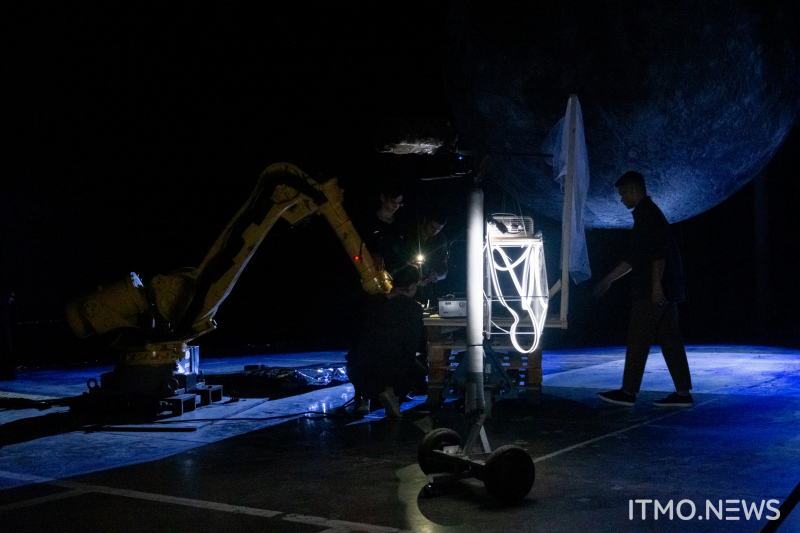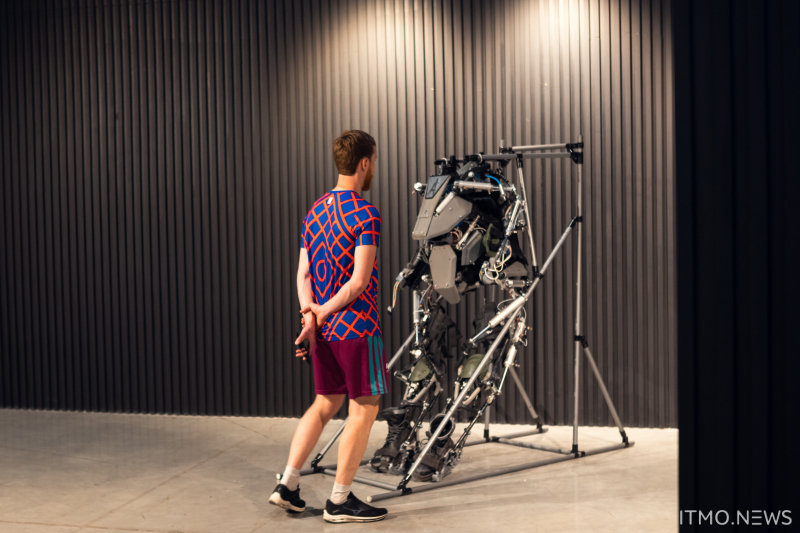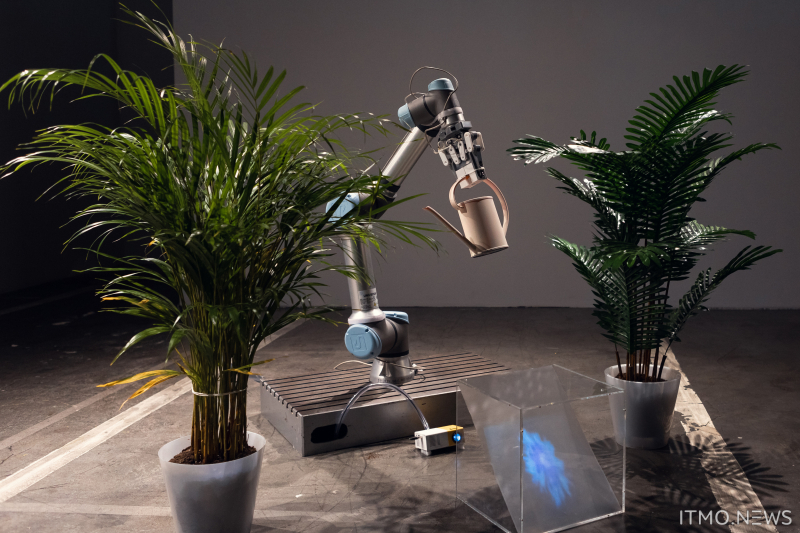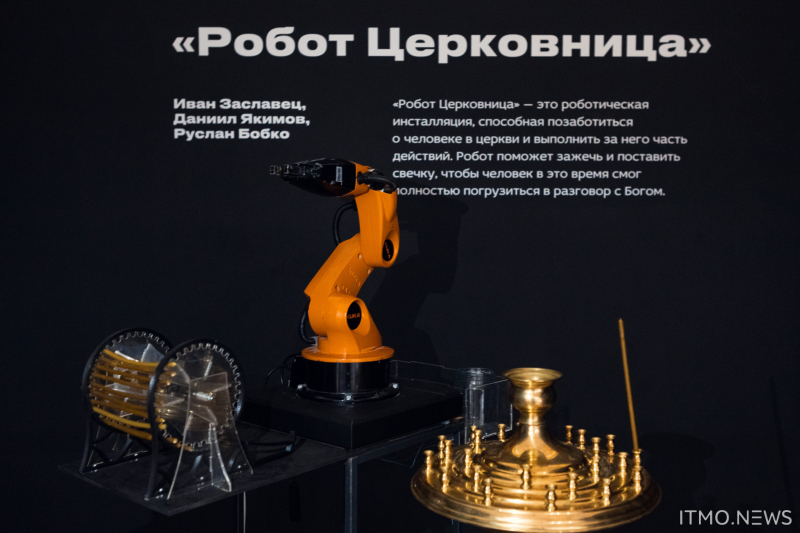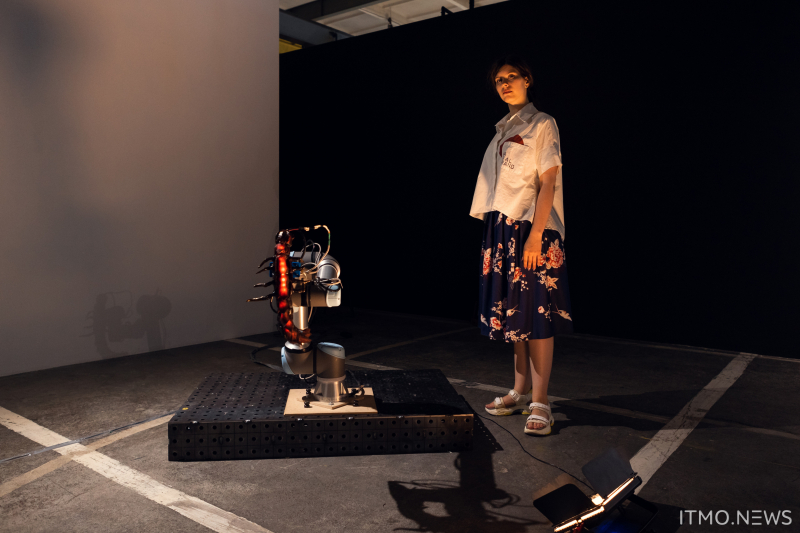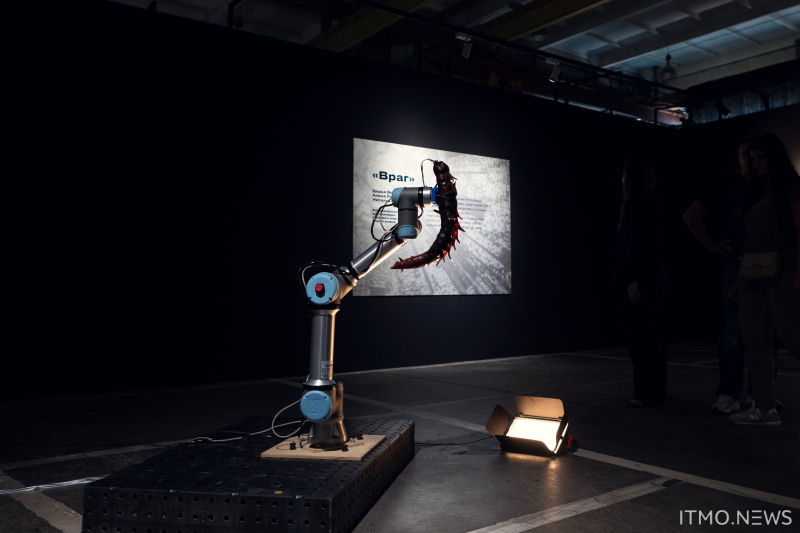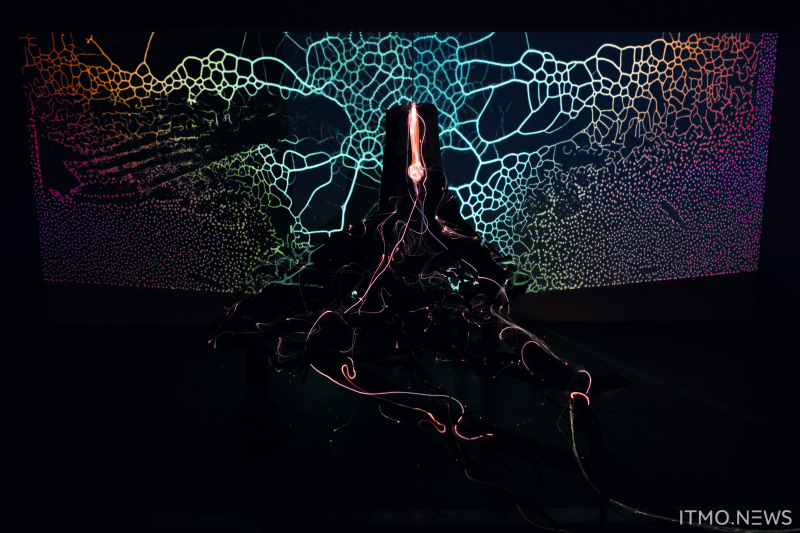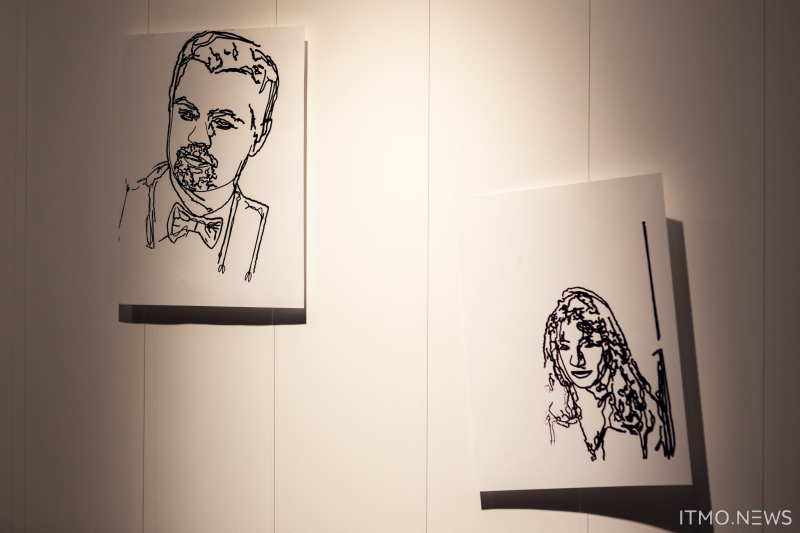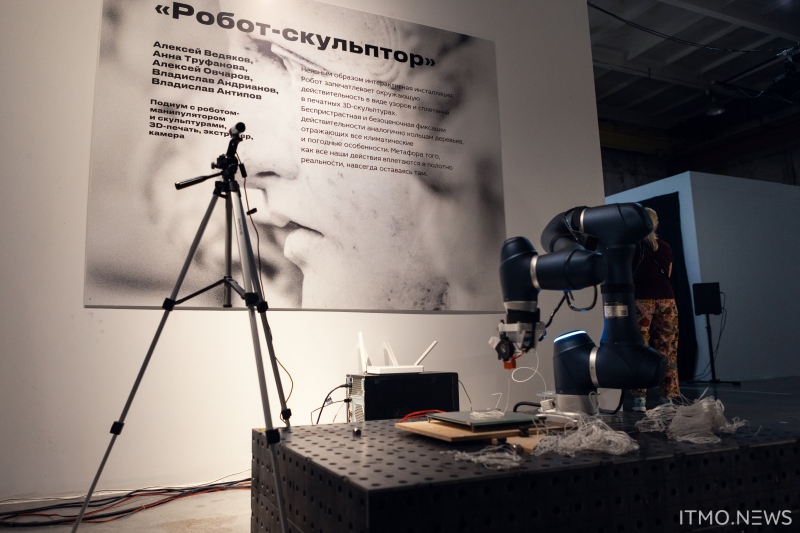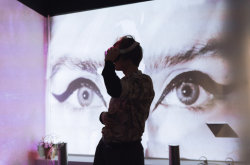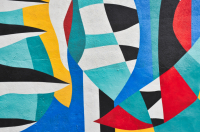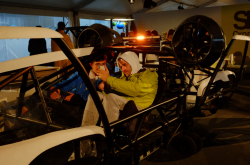The art of robots
The Caring Robots exhibition, which was put together by ITMO’s Faculty of Control Systems and Robotics and Art & Science Center, became a place of experimenting and breaking new grounds for the university’s students. As noted by Anton Pyrkin, the exhibition’s chief initiator and director, as well as the head of ITMO’s Faculty of Control Systems and Robotics, it was an excellent chance for future robotics specialists to pick up a brush and for Art & Science students – to expand their expertise with advanced novel technologies.
“This exhibition for us meant stepping into a new world, unknown yet exciting. This way, we could show people what we can do and get feedback,” explains Anton Pyrkin.
To encourage students on their art journey, ITMO University established a specialized robotics workshop (part of the university’s Art & Science M-Platform), which will be afterwards open to all students, and offered Art & Science majors to take a course in intelligence robotics to learn how to code and make robots take over creative tasks in just one semester.

The Caring Robots exhibition. Photo by Anton Pyrkin
Gestures of caring and human-robot interaction
The end of both courses was marked by a large-scale exhibition at Sevkabel Port offering visitors a 2,000-meter futuristic space with 17 installations created by students of the Faculty of Control Systems and Robotics and Art & Science Center.
The display is divided into five key zones (Prolog (Exoskeletons), Caring Gestures, Communication, Robot’s Job, and Robots Play). Each zone focuses on a certain function of robots, be it cyberware, service robots, communication tools, robotic replacement, or robot artists.
Upon entering the exhibition, visitors first see the famous futuristic exoskeletons developed by Alexey Ledyukov, a Bachelor’s student at ITMO’s Faculty of Control Systems and Robotics, and a robotic wing that can imitate a bird’s flight.
The next hall, Caring Gestures, depicts the artists' visions on how deeply people trust robots and are willing to delegate them their everyday tasks and even fulfill their spiritual needs. One of the artists’ works is a robotic church lady who can light a candle on a person’s behalf, thus freeing them from the physical act to entirely draw in spiritual energy. Whereas a robot gardener from the Perception installation treats plants with loving care, be they living or artificial. With this robot, the artist raises the question of empathy in artificial intelligence. Though machines may not show empathy towards people just yet, it perfectly works the other way round, especially if a person sees a robot that pays attention to plants and can hold a profound conversation about classical music.
The Enemy installation features a robotic arm that grips a mysterious creature, leaving it no chance to escape. One of the authors, Daria Vysokova, shares that the creature stands for everything biological, chthonic, natural, and vicious in humans, which is trying to break free but can’t because the human mind (or an artificial one) has a firm grip on it.
“We purposely chose an image that would frighten people. We can’t say for sure whether we feel sorry for this creature or expect a robot to protect us. Is it a creature that can’t escape because the machine is holding it tight or is the robot trying to let it go even though it was programmed not to? What if the machine decides to break the code? Would the creature then attack the robot, flee, or stay still? Through this concept, we reflect on the future relationships between humans and AI,” says the author of the project.
Understanding robots
The highlight of the exhibition is an assortment of projects presented by Dmitry Morozov (aka ::vtol::), a prominent media artist and a lecturer at ITMO’s Art & Science Center, who desires to get to the bottom of non-living experiences and human-robot interactions. His Phase Adventure, which has already been on display at Anna Nova Gallery, replicates what’s happening inside technologies, demonstrating visitors how machines think, feel, and act. Its internal mechanism, deliberately non-functional, moves following the changes in its external environment: time, sound, temperature, the positions of planets, their inner state, and so on. While these movements remain obscure, we can only take note of these patterns not quite understanding the inner motives of the machine. Resistor is another object with its own private life. It’s made of magnetite crystals and serves exclusively to measure the electrical conductivity of objects and build graphs so that a different algorithm could use this data to synthesize sound.
This zone also features some other artworks that have already been exhibited before, namely, BREAK-IN by Alexander Pogrebnyak and Anton Shchegolev and Grigory Kirgizov’s Cyberrhiza.
Inside robots
The Robot’s Job hall contains the greatest number of installations, mainly lab robotic projects. Among them are a one-of-its-kind robot artist and sculptor, which, though, meant to be rather practical, can in fact, create art just like human artists, albeit using loaded data. The robots are rather popular among visitors and have even received quite a few commercial orders.
Another exhibit is a mobile robotic platform equipped with a camera that can map the surrounding space in real time. The robots scan the environment, analyze it, and decompose it semantically into separate objects using the SLAM (simultaneous localization and mapping) method and deep neural networks. With this technology, visitors can have a deeper look inside technological marvels, learn how they work, and see the world through the “eyes” of robots.
The last show on Earth
In a sense, the Caring Robots exhibition starts a dialogue on the capabilities of robots, the gap between humans and machines, and the future of robotics. The question is, will robots replace humans not only in manufacturing but in the art world, too?
The students of ITMO’s Youth Robotics Lab together with their supervisor Igor Lositskiy have long been working on a robotic musical ensemble. Each year, the team has a roaring success at RoboCup competitions.

One of the members of the musical ensemble. Photo by Dmitry Grigoryev / ITMO.NEWS
Not far behind in terms of popularity, the Robot Kostya play is yet another take on genre experiments that was staged at the Tochka Dostupa festival in the summer of ‘21. The show has already been part of the theater festival of the New Stage of the Alexandrinsky Theater and was nominated for the Golden Mask award.
Robot Kostya is an hour-long story about robots that rehearse Anton Chekhov's Seagull using the étude method introduced by Konstantin Stanislavsky. Although the robots know the location, roles, and lines, which should help them get into their characters, they, as odd as it may sound, have no particular acting algorithm. They don’t understand what their characters are trying to say so they randomly throw in lines from the play loaded into their systems. What’s more, they can break or fail due to a power outage, thus ruining the show. Nevertheless, the robot performers continue to rehearse and even line up for their bows expecting the crowd’s applause, even when the audience has left. Yet when the room is still full, the show’s director Ivan Zaslavets comes out after each performance to compare whether the audience went silent longer or shorter than the first spectators of Chekhov’s play did.
Each performance is different, says the director. The robots’ actions and behavior are never the same, which, among other things, depends on how well the audience knows the original text. Though the show was entirely created by humans (a team of directors, choreographers, media artists, and robotics engineers), robots pitched in to make this happen, too.
“Robots play a significant role in our show. During rehearsals, their technical failures made them do odd yet fascinating things, which we then used in the play. Some of the scenes are improvised, too. To make this play, we used various interaction methods and studied the features of each of our robots, including their moves and behaviors. Our robotic team consists of long-standing performers, our own robotic inventions, and invited artists,” explains Ivan Zaslavets.
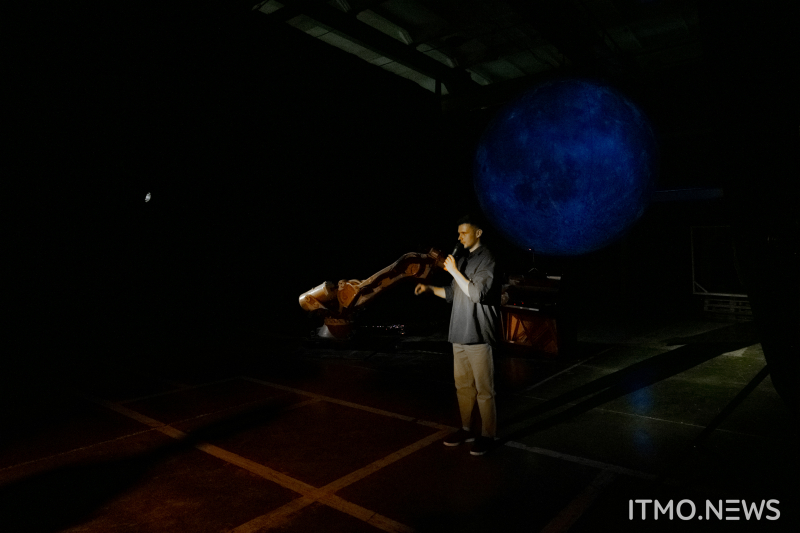
Ivan Zaslavets at the end of a Robot Kostya rendition. Photo by Ekaterina Shevyreva / ITMO.NEWS
The last weekend of the exhibition will be marked with six performances of the play.
The exhibition will run till July 10 at Sevkabel Port. Its working hours are from 12 PM to 11 PM. Tickets to the exhibition can be purchased online or on the spot. Please note that you will need to buy a separate ticket in order to attend the performance.
